| Listing 1 - 10 of 11 | << page >> |
Sort by
|
Book
ISBN: 9780199297788 Year: 2014 Publisher: Oxford Oxford university press
Abstract | Keywords | Export | Availability | Bookmark
 Loading...
Loading...Choose an application
- Reference Manager
- EndNote
- RefWorks (Direct export to RefWorks)
Book
Year: 1968 Publisher: Utrecht Antwerpen Uitgeverij " Het Spectrum "
Abstract | Keywords | Export | Availability | Bookmark
 Loading...
Loading...Choose an application
- Reference Manager
- EndNote
- RefWorks (Direct export to RefWorks)
Natuurkunde --- Physique --- Sciences pures --- Zuivere wetenschappen --- Electrons --- Elektronen --- 539.124
Book
ISBN: 9971507331 Year: 1989 Publisher: Singapore World Scientific
Abstract | Keywords | Export | Availability | Bookmark
 Loading...
Loading...Choose an application
- Reference Manager
- EndNote
- RefWorks (Direct export to RefWorks)
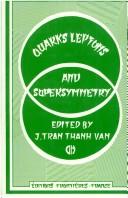
ISBN: 2863320106 Year: 1981 Publisher: Gif sur Yvette Éd. Frontières
Abstract | Keywords | Export | Availability | Bookmark
 Loading...
Loading...Choose an application
- Reference Manager
- EndNote
- RefWorks (Direct export to RefWorks)
Leptons (Nuclear physics) --- Quantum chromodynamics --- 539.124 --- 539.1 --- 539.1 Nuclear physics. Atomic physics. Molecular physics --- Nuclear physics. Atomic physics. Molecular physics --- 539.124 Electrons. Negatrons (including beta-particles). Positrons --- Electrons. Negatrons (including beta-particles). Positrons --- Congresses --- Elementary particles
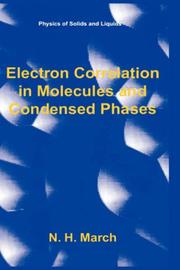
ISBN: 0306448440 1489913726 148991370X 9780306448447 Year: 1996 Publisher: New York, N.Y. Plenum
Abstract | Keywords | Export | Availability | Bookmark
 Loading...
Loading...Choose an application
- Reference Manager
- EndNote
- RefWorks (Direct export to RefWorks)
Quantum chemistry --- Elementary particles --- fysicochemie --- Molecular physics --- Condensed matter --- Electron configuration --- Molecules --- 539.124 --- #WSCH:AAS2 --- Configuration, Electron --- Electron correlation --- Atomic orbitals --- Electrons --- Condensed materials --- Condensed media --- Condensed phase --- Materials, Condensed --- Media, Condensed --- Phase, Condensed --- Liquids --- Matter --- Solids --- Electrons. Negatrons (including beta-particles). Positrons --- 539.124 Electrons. Negatrons (including beta-particles). Positrons
Book
ISBN: 0123263506 1322290172 1483191664 Year: 1978 Publisher: New York Academic press
Abstract | Keywords | Export | Availability | Bookmark
 Loading...
Loading...Choose an application
- Reference Manager
- EndNote
- RefWorks (Direct export to RefWorks)
Theoretical spectroscopy. Spectroscopic techniques --- fysicochemie --- 543.422.27 --- Electron paramagnetic resonance spectroscopy --- 539.124 --- Electron spin resonance spectroscopy --- EPR spectroscopy --- ESR spectroscopy --- Spectrum analysis --- Using ultra-high frequency electromagnetic waves (microwaves). Electron spin resonance spectroscopy --- Electrons. Negatrons (including beta-particles). Positrons --- 539.124 Electrons. Negatrons (including beta-particles). Positrons --- 543.422.27 Using ultra-high frequency electromagnetic waves (microwaves). Electron spin resonance spectroscopy
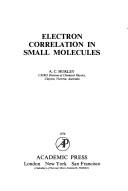
ISBN: 0123624509 9780123624505 Year: 1976 Volume: 6 Publisher: London Academic press
Abstract | Keywords | Export | Availability | Bookmark
 Loading...
Loading...Choose an application
- Reference Manager
- EndNote
- RefWorks (Direct export to RefWorks)
Molecular physics --- Molecular theory --- Electron configuration --- Théorie moléculaire --- Electrons --- Corrélation --- 539.124 --- #WSCH:AAS2 --- Configuration, Electron --- Electron correlation --- Atomic orbitals --- Chemistry, Physical and theoretical --- Matter --- Electrons. Negatrons (including beta-particles). Positrons --- Constitution --- Electron configuration. --- Molecular theory. --- 539.124 Electrons. Negatrons (including beta-particles). Positrons --- Théorie moléculaire --- Corrélation
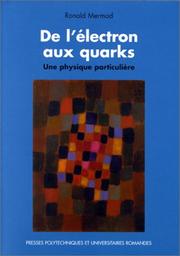
ISBN: 2880744067 288074394X 9782880744069 Year: 1999 Publisher: Lausanne : Presses polytechniques et universitaires romandes,
Abstract | Keywords | Export | Availability | Bookmark
 Loading...
Loading...Choose an application
- Reference Manager
- EndNote
- RefWorks (Direct export to RefWorks)
Particules (Physique nucleaire) --- 539.124 --- Electrons. Negatrons (including beta-particles). Positrons --- 539.124 Electrons. Negatrons (including beta-particles). Positrons --- Algèbre --- Mathématiques antiques --- Mathématiques médiévales --- Mathématiques --- Algebra --- Mathematics, Ancient --- Mathematics, Medieval --- Histoire --- History --- Mathématiques antiques. --- Mathématiques médiévales. --- Histoire. --- Algèbre --- Mathématiques antiques. --- Mathématiques médiévales. --- Mathématiques
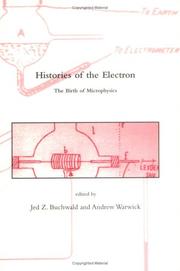
ISBN: 0262269481 1423730704 9780262269483 9780262524247 0262524244 9780262024945 0262024942 Year: 2001 Publisher: Cambridge (Mass.): MIT press
Abstract | Keywords | Export | Availability | Bookmark
 Loading...
Loading...Choose an application
- Reference Manager
- EndNote
- RefWorks (Direct export to RefWorks)
In the mid to late 1890s, J.J. Thomson and colleagues at Cambridge's Cavendish Laboratory conducted experiments on "cathode rays" (a form of radiation produced within evacuated glass vessels subjected to electric fields) -- the results of which some historians later viewed as the "discovery" of the electron. This book is both a biography of the electron and a history of the microphysical world that it opened up. The book is organized in four parts. The first part, Corpuscles and Electrons, considers the varying accounts of Thomson's role in the experimental production of the electron. The second part, What Was the Newborn Electron Good For?, examines how scientists used the new entity in physical and chemical investigations. The third part, Electrons Applied and Appropriated, explores the accommodation, or lack thereof, of the electron in nuclear physics, chemistry, and electrical science. It follows the electron's gradual progress from cathode ray to ubiquitous subatomic particle and eponymous entity in one of the world's most successful industries -- electronics. The fourth part, Philosophical Electrons, considers the role of the electron in issues of instrumentalism, epistemology, and realism. The electron, it turns out, can tell us a great deal about how science works.
Electrons --- Physics --- Physical Sciences & Mathematics --- Nuclear Physics --- Corpuscular theory of matter --- History. --- Thomson, J. J. --- Thomson, J. J., --- Thomson, Joseph John, --- Thompson, J. J. --- Atoms --- Leptons (Nuclear physics) --- Matter --- Particles (Nuclear physics) --- Cathode rays --- Ions --- Positrons --- Constitution --- SCIENCE, TECHNOLOGY & SOCIETY/History of Science --- PHYSICAL SCIENCES/General --- ENGINEERING/Electrical Engineering --- Metaphysics --- Philosophy of nature --- Philosophy of science --- 539.124 <09> --- 539.124 <09> Electrons. Negatrons (including beta-particles). Positrons--Geschiedenis van ... --- Electrons. Negatrons (including beta-particles). Positrons--Geschiedenis van ... --- History
Book
ISBN: 0471084743 Year: 1982 Publisher: New York (N.Y.): Wiley
Abstract | Keywords | Export | Availability | Bookmark
 Loading...
Loading...Choose an application
- Reference Manager
- EndNote
- RefWorks (Direct export to RefWorks)
Chemical reaction, Conditions and laws of --- Electronic structure --- #WSCH:AAS2 --- 539.124 --- 541.124 --- Structure, Electronic --- Atomic structure --- Energy-band theory of solids --- Conditions and laws of chemical reaction --- Reaction, Conditions and laws of (Chemistry) --- Chemistry, Physical and theoretical --- Physical laws --- 539.124 Electrons. Negatrons (including beta-particles). Positrons --- Electrons. Negatrons (including beta-particles). Positrons --- 541.124 Chemical dynamics in general. Reaction mechanism in general --- 541.124 Limits of reactions --- Chemical dynamics in general. Reaction mechanism in general --- Limits of reactions --- Chemical thermodynamics --- fysicochemie
| Listing 1 - 10 of 11 | << page >> |
Sort by
|

 Search
Search Feedback
Feedback About UniCat
About UniCat  Help
Help News
News